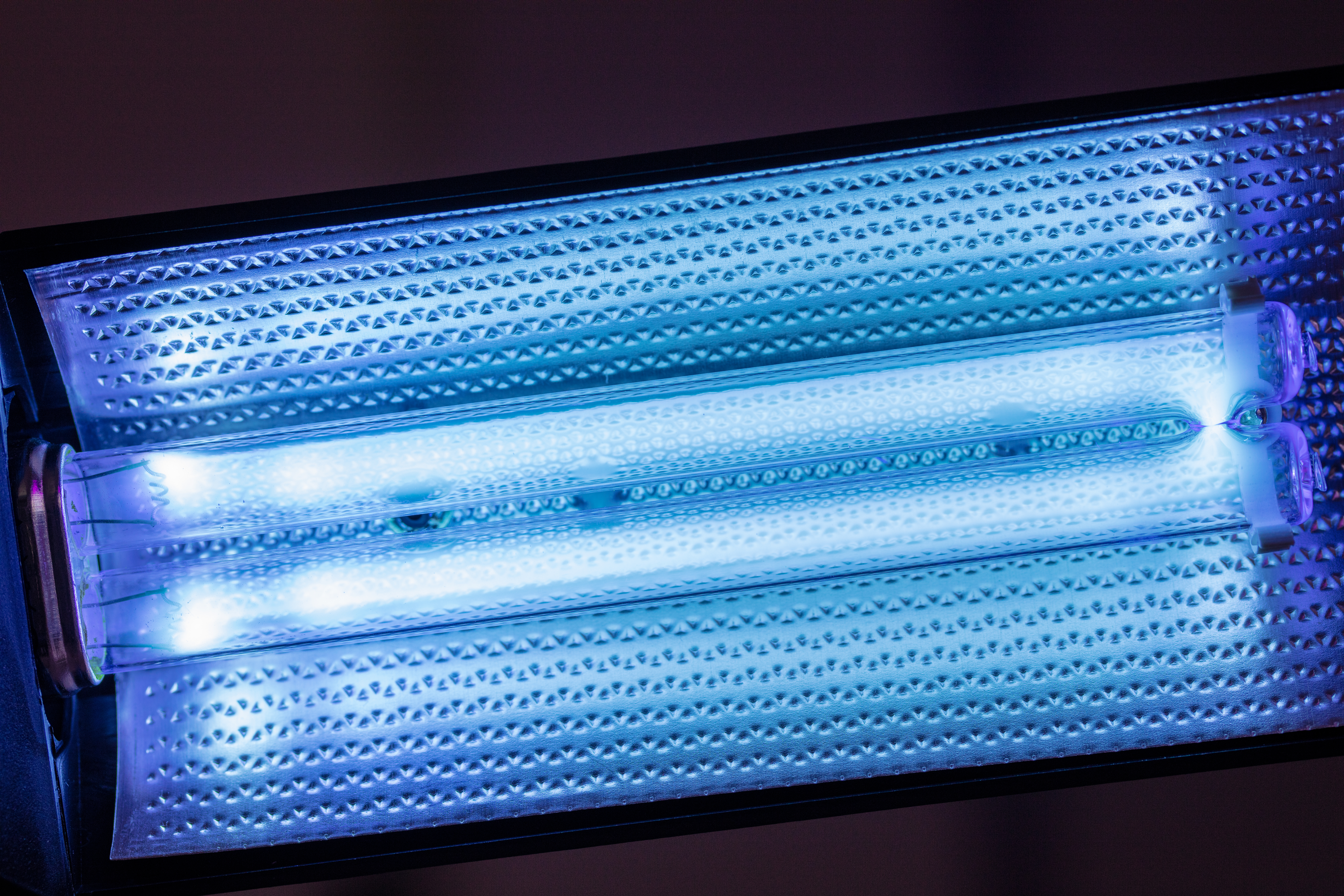Being healthy is directly related to your comfort at home. Ultraviolet or UV lights in HVAC systems are one method that homeowners use to improve indoor air quality. The objective of these lights is to protect the air quality in your house from airborne pathogens. When used in tandem with other indoor air quality services, they can help to create a healthy indoor environment.
Understanding UVC Light
UV radiation has a wavelength ranging from 200 to 280 nanometers. This class of radiation is found within the electromagnetic spectrum between visible light and X-rays. Ultraviolet light comes in three categories, called UVA, UVB and UVC. The sun produces all three forms of UV radiation, but the atmosphere reflects the UVC waves while allowing the UVA and some of the UVB radiation to pass through. UVA is the safest form of ultraviolet light for human skin, and most tanning beds emit UVA with a small amount of UVB. UVC is the most harmful to human skin and eyes and is typically only found in germicidal applications. Due to the risk of harm to the eyes and skin, UVC lamps are designed to operate in a location that cannot be easily seen.
UVC Radiation and Microbes
When exposed to the UVC spectrum, the DNA and RNA of microbes like mold, viruses, and bacteria are damaged. This process is called denaturing, and it affects the ability of these microorganisms to replicate. More specifically, the base molecules on the DNA/RNA helix get bonded together in a way that stops the chain from being able to split and replicate. While UV light does not always kill the pathogens, they are no longer able to reproduce and spread, which limits their ability to cause disease or allergy symptoms.
This process works best on microbes because they are made of a single cell that splits to breed. Larger creatures like insects or rodents will still have the same damage to the outside cells on their bodies, but it cannot penetrate every cell in the body in the same manner.
Photocatalytic Oxidation
UV lights may be a part of VOC (volatile organic compound) removal through a process called photocatalytic oxidation or PCO. These systems combine standard UVC lamps with a titanium-coated filter. The UV radiation releases electrons from the titanium into the air. The electrons then react with water to create particles called hydroxyl radicals, which are highly charged and drawn to organic compounds like those found in VOC gases. The radicals dissolve the bonds of these organic compounds and break them into smaller, safer particles like carbon dioxide and water. If the UV system is designed to work with VOCs, they will also remove related odors from the air.
UV and Other Airborne Contaminants
Ultraviolet wavelengths are very helpful for living microbes, but they don’t help with other kinds of contaminants. Dust that is not made up of living creatures will not be altered by UV and will need to be physically screened from the air with a filter. If the UV lamp is not part of a PCO system, VOCs and other gases must be removed from the air through ventilation or with the use of air scrubbers.
Installation within the HVAC System
UV lamps for HVAC systems are most commonly mounted inside the air handler unit or ductwork. The air that reaches the UV light has already been filtered, so larger particles like dust have already been removed. During heating and cooling operations, air will blow through the passage lit by UV. To place the UV lamp in the most effective location, it is best to work with a professional who can make sure that it can maximize the amount of exposure to your indoor air. Technicians will also ensure that this sanitizing technology is in a location that is safe from exposure risk.
Heat pumps and other systems that rely on condensation coils can also use UV technology in this area to reduce any risk of mold accumulation. Since the moisture of condensation is an ideal environment for mold and mildew, adding a source of UV light in this area can keep airborne spores from landing and replicating.
UV systems can also be used for water purification. If your HVAC unit has a built-in humidifier, there may also be a UV purification component that is tied to the water source for this machine.
Take advantage of our online promotions and save big on your next service appointment!
Who Benefits From HVAC UV Lights?
UV systems have become standard in healthcare settings where high-risk patients regularly visit. However, there are plenty of reasons to get a UV system in a residential home. If you have family members with allergies or compromised immune systems, the system provides an additional line of protection. Homes in high-humidity areas that are at risk of mold can be protected from structural damage. If your home has a lot of indoor/outdoor pets that are bringing in dirt and other pathogens, UV can reduce the risk of spread. People who are sensitive to VOCs or strong smells may also benefit from this technology.
Cleaning and Inspection
UV systems are very low maintenance once they are installed. However, annual inspection and maintenance can ensure that they are functioning efficiently. This is most commonly a part of your annual HVAC maintenance appointment and does not require a separate visit. At this time, they will inspect and clean the area where the UV lamp sits. If a bulb is no longer functioning, they will replace it.
Monitoring Operation and Professional Inspections
Due to their out-of-the-way location, UV purifiers commonly come with built-in monitoring systems. This may be as simple as an indicator light that says that a bulb is low or not functioning. However, smarter UV monitoring systems may offer additional data about things like performance, cleanliness, airflow and air quality metrics.
Ensuring Proper Airflow
To operate efficiently, UV lights need sufficient circulation to cure the air that enters your HVAC system. Make sure the air filters in your HVAC system are clean and changed regularly. Clogged or unclean filters can decrease the airflow. Make sure that your air intake is free from obstructions like curtains and furniture.
To optimize their exposure to the passing air, check that the UV lights are positioned correctly within the HVAC system. Your professional installer should refer to the manufacturer’s instructions and the layout of your system to find the best location for your home.
Work With the Pros
[company name] in Gilbert is your dependable collaborator for all your HVAC UV light installation solutions. Our services include HVAC systems installation, inspection, air conditioning repair, and maintenance. We work with gas and electric furnaces, heat pumps, mini-splits and air conditioners. Our plumbing department provides drain cleaning, pipe repairs and replacements, leak detections, water heaters, water treatment systems, fixture installations and repairs, gas line services and sewer services. We offer services and products for thermostats, air quality, ductwork services, commercial services, package units, condensers and specialized services. Contact us today to learn more.





